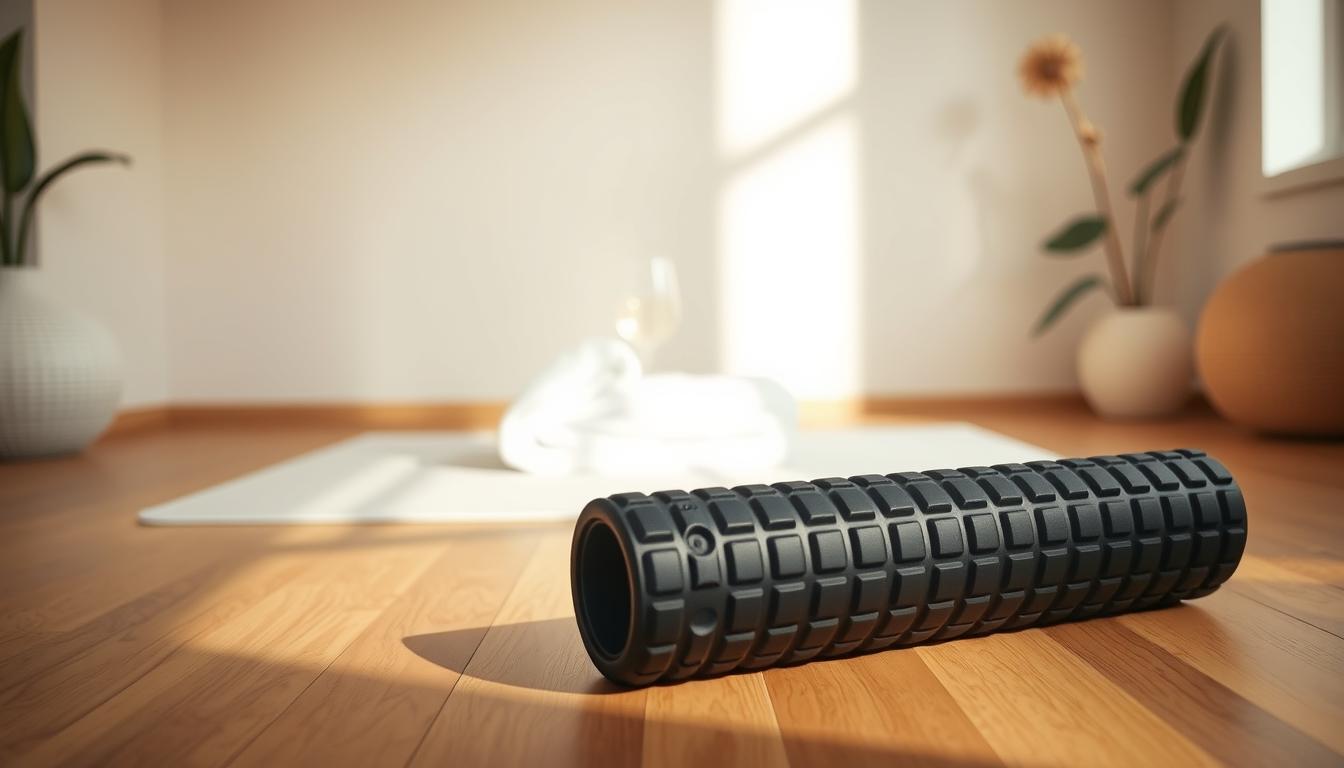In our busy lives, lots of people face neck pain and stiffness. This can really interfere with daily activities. Luckily, doing neck roll exercises can help you feel more relaxed and reduce pain. These moves make your neck more flexible and ease tension. If you make these simple exercises part of your day, you can lessen pain and feel better overall.
Understanding Neck Pain and Stiffness
Neck pain and muscle stiffness are things many people deal with every day. These problems can come from not sitting right, sitting too long, or stress. Knowing about neck pain is key because it affects how we feel and live.
Often, people say their necks are stiff, making it hard to move. This stiffness can make even simple things tough to do. By noticing these troubles early, steps can be taken to feel better soon.
Common Causes of Neck Strain
Knowing why neck strain happens is key to preventing it. Poor posture is a big cause, especially from long hours in front of the computer or lots of texting. Sitting slouched can make your muscles tired and your neck hurt.
Another big cause is digital stress. With so much tech use, we often hold our heads at weird angles to look at screens. This bad position puts a lot of stress on neck muscles. If we don’t support our necks right, it gets worse.
Muscle fatigue also plays a big role in neck strain. When our muscles work too hard or stay in one spot for too long, they get tight and sore. Knowing this, we can do things like neck rolls to keep our necks flexible and pain-free.
Importance of Neck Flexibility
Keeping your neck flexible is key for healthy muscles and moving easily. A stiff neck can make it hard to move and cause pain. This limits what you can do every day. By working on neck flexibility, daily tasks become easier since your range of motion improves.
Doing flexibility exercises like neck rolls helps prevent injuries. When your neck muscles are flexible, they can handle stress better. This means you’re less likely to get strained muscles or chronic pain. Plus, flexible muscles help you maintain good posture and move more smoothly.
Exercises that focus on making your neck more flexible are good for your muscles. They also support your overall health. By understanding how important neck flexibility is, you set yourself up for better movement. This also lowers your chance of getting hurt as time goes on.
Neck Roll Exercises for Relaxation and Pain Relief
Adding neck roll exercises to your daily routine offers many perks. They’re a core part of good relaxation habits. These exercises lower muscle tightness, boost flexibility, and help you relax overall. They make your mind feel calm too.
Benefits of Performing Neck Rolls
Neck rolls give lots of benefits:
- Alleviates tension in neck muscles
- Improves blood circulation
- Enhances range of motion
- Reduces stress and anxiety
- Supports spinal alignment
Doing neck rolls often leads to better neck movement and less pain.
How Often Should You Do Neck Rolls?
It’s best to do neck rolls often to get the most from them. Aim to:
- Do them every day for 5-10 minutes
- Take short breaks to do them if you sit a lot
- Add them to your morning or night routine
Sticking to a regular schedule will help you get better neck health over time.
Precautions Before Starting Neck Exercises
Before starting any neck exercises, it’s important to be cautious. This is very important for people who have a lot of neck pain or worrying signs. If you exercise without good advice, you could hurt yourself more. Talking to a healthcare professional first can spot issues that might make pain worse. This step is key in taking care of pain.
Consulting with Your Healthcare Provider
Talk to your healthcare provider before beginning neck exercises. They can check your neck and suggest the best exercises or changes you might need. Their knowledge helps avoid risks and makes sure your exercises are right for your health. Getting the right advice is essential for your health and managing pain.
Simple Techniques for Effective Neck Rolls
Doing neck rolls right can make you more flexible and less tense. This part of the guide shows you how to nail the technique. By following these steps, you can do neck rolls safely. Also, thinking about what you’re doing can make you even better.
Step-by-Step Guide to Neck Rolls
To get the best results from neck rolls, follow this guide:
- Start by sitting or standing comfortably with your back straight.
- Relax your shoulders and let your arms hang by your sides.
- Gently tilt your head forward, bringing your chin to your chest.
- Slowly roll your head towards your right shoulder.
- Keep going, tilting your head back to look at the ceiling.
- Roll your head to the left, getting back to where you started.
- Do this several times, trying to move a little more each time.
Visualization Techniques for Better Performance
Thinking certain thoughts can make your neck rolls better. Picture your neck as something that lets go of stress with each roll. Imagine the muscles getting looser with every turn. This focus can really help your practice and make it feel more rewarding.

Other Neck Stretches for Pain Relief
Adding different neck stretches can greatly help with pain relief and make your neck more flexible. Doing forward and backward tilts, along with side rotation stretches, helps ease the tension. They are key parts of any stretch routine.
Forward and Backward Tilts
Forward and backward tilts are soft moves aimed at certain neck areas. To do these flexibility exercises:
- Start by standing or sitting straight.
- Gently lower your chin to your chest. Make sure your shoulders stay relaxed.
- Hold for 15-20 seconds. You should feel the stretch in the back of your neck.
- Go back to the starting position.
- Then, gently tilt your head back to look at the ceiling.
- Hold again for 15-20 seconds before going back to the neutral spot.
Side Rotation Stretches
Side rotation stretches are good for making your neck flexible and releasing tension. To do these stretches:
- While sitting or standing, keep your back straight and shoulders at ease.
- Turn your head to the right, getting your chin close to your shoulder.
- Keep this pose for 15-20 seconds.
- Return to center and do it on the left side.
Self-Massage Tools for Neck Relief
Caring for your neck boosts your overall comfort. Self-massage tools like foam rollers and tennis balls help ease tension. These tools are simple but effective in making you feel more relaxed.
Foam Rollers and Their Benefits
Foam rollers are great for massaging the neck and upper back. By using your own weight, you can roll out tightness. This not only improves circulation but also helps muscles recover faster.
Using foam rollers often increases flexibility. It also reduces the risk of hurting your neck.
Using Tennis or Lacrosse Balls for Neck Pain
Tennis balls relieve neck pain effectively. Put a ball between your neck and a wall for pressure on sore spots. This technique feels like a deep tissue massage and is very safe.
Lacrosse balls are harder, offering stronger relief. They work well for those who prefer a deeper massage.
Incorporating Neck Rolls into Your Daily Routine
Adding neck rolls to your daily habits can make you feel more comfortable and less tense. If you adjust your work habits, you’ll likely stand straighter and move more easily. Making your office a place where you can do neck exercises every day helps a lot. It’s especially good for people who sit at a desk for hours.
Neck Exercises at the Office
You can fight stiffness by doing stretches at your desk. Try adding these steps to your day:
- Do quick neck rolls every hour to stay limber.
- Spend five minutes stretching your neck from side to side.
- Stand and stretch regularly to keep the blood flowing.
Stretching Breaks During Long Hours of Work
Taking breaks for stretching is key to staying both mentally and physically healthy. Remember to pause for short stretches, like:
- Breathe deeply while reaching your arms out for a few moments.
- Move your shoulders back and forth to ease stress.
- Do gentle neck stretches to fight the strain of sitting too long.
When to Seek Professional Help
Knowing when to seek help for neck pain is key, especially if it’s severe. If the discomfort lasts long, or if pain spreads and stiffness is bad, it’s time to see a doctor. Getting help early can manage the pain better and help you feel good again.
Identifying Serious Neck Issues
Being aware of serious neck problem signs is important. If you have:
- Severe pain not eased by home remedies
- Numbness or tingling feelings in arms or hands
- Weak arm or hand muscles
- Problems controlling bladder or bowel
- Symptoms that don’t go away for weeks
Such symptoms mean you might need urgent help from a health expert.
Alternative Therapies for Chronic Neck Pain
There are many treatments for long-term neck pain besides usual care. Such as:
- Acupuncture: Helps lessen pain and betters movement
- Chiropractic care: Fixes spine and neck alignment problems
- Physical therapy: Custom exercises and treatments make neck muscles stronger
- Meditation and mindfulness: Stress reduction can ease the neck’s tension
Conclusion
Neck roll exercises can make your neck more flexible and reduce pain. We’ve looked at ways to ease neck strain, including stretches and massages. Doing these regularly can lessen stiffness and keep your neck healthy.
Adding these exercises to your day can have long-term perks. Doing neck rolls and stretches at home or work can boost your well-being. Let’s commit to caring for our necks daily to avoid future problems.
The secret to a healthy neck is to keep practicing and to listen to your body. Simple changes can increase your comfort and movement. Start these techniques today and move towards a life without neck pain.



